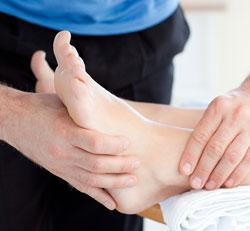At- Home Tips to Keep Diabetic Complications at Bay
posted: Aug. 18, 2014.
The National Diabetes Statistics Report found that in 2012, about 9.3 percent of the US population had diabetes, with 1.7 million new diagnoses made each year. While diabetes can come with a host of complications from kidney disease and stroke to eye problems, it’s easy to keep diabetes in check with the proper care and treatment plan. This also means making a much-needed appointment to see your podiatric doctor. While it’s important that diabetic feet get the medical attention they deserve, there are also some things you can do to ensure that your feet remain healthy and happy. 

Invest in proper footwear
While it might not seem like shoes are the most important part of your diabetic foot care equation, even the slightest rubbing from your shoes could cause a blister, which could quickly turn into an infected sore that just won’t heal. No one wants to deal with these types of complications. Prevent this from happening by choosing shoes that truly conform to your feet.
Nip problems in the bud by wearing different socks or by changing shoes at the first signs of irritation or redness. This will ensure that foot problems don’t get worse. Also, because feet tend to grow larger throughout the day, it’s best to shop for new shoes later in the day.
Inspect your feet
Anyone with diabetic feet should be examining their feet every day. This includes checking between toes where blisters and infections can occur. If you’re unable to properly check your feet, ask a family member to help.
Don’t bare it
While you might love the look of a nice pair of stockings, they often don’t provide enough protection again calluses. Instead, opt for socks, which will prevent sores from occurring. Also, since leather, man-made materials and plastic can often irritate skin and cause blisters, it’s particularly vital to wear socks with these types of shoes. Thicker socks will also offer you more padding and protection while walking.
Wash with warm water
It’s important to wash your feet everyday with warm—but not hot—water. If your feet don’t respond to heat, it might be best to check the water with your hands first to check that the temperature is just right. After washing up, make sure to fully towel off your feet and toes to prevent fungal infections.
Say something
If you notice any tingling, numbness or pain, it’s time to see your podiatric specialist right away. Even the slightest change in your foot health could be a sign of trouble. Don’t wait until it becomes a full-blown problem. Even if the symptoms seem minor, it’s best to come in for a visit. Always play it safe!
If you have diabetes and need to schedule your next visit with your podiatric specialist, call us at (773) 625-2211.
Do you have any other at-home tips to add to this list? We know that when it comes to diabetes, it’s best to take every precaution when it comes to the health of your feet. We want to know what care and advice you can add to this growing list.

